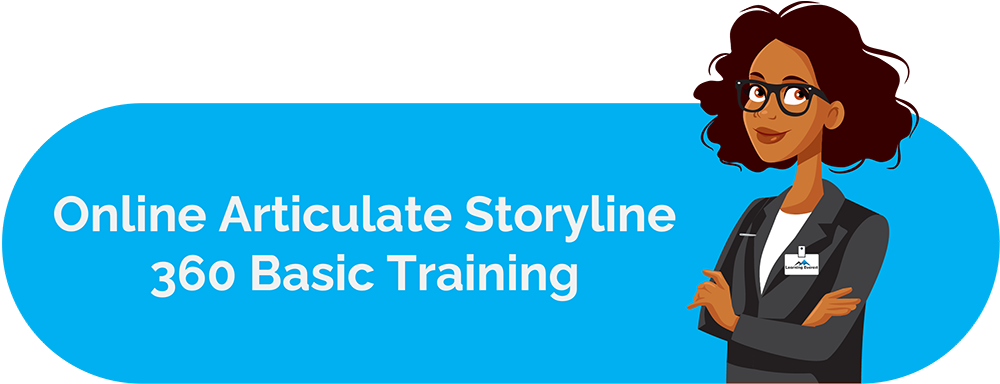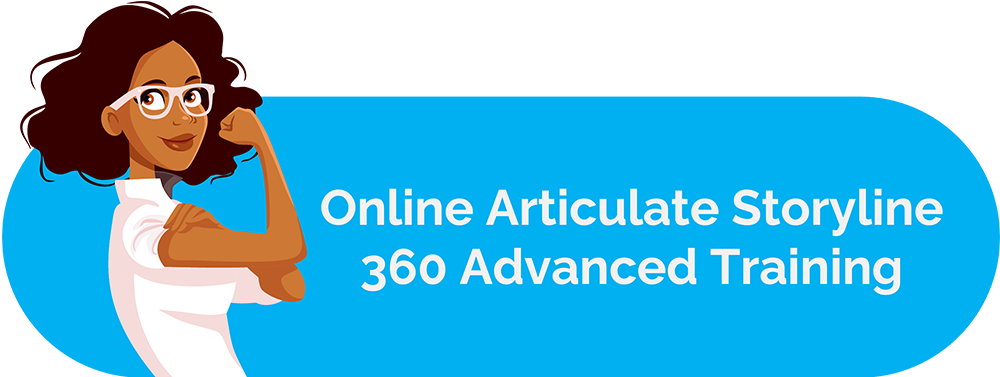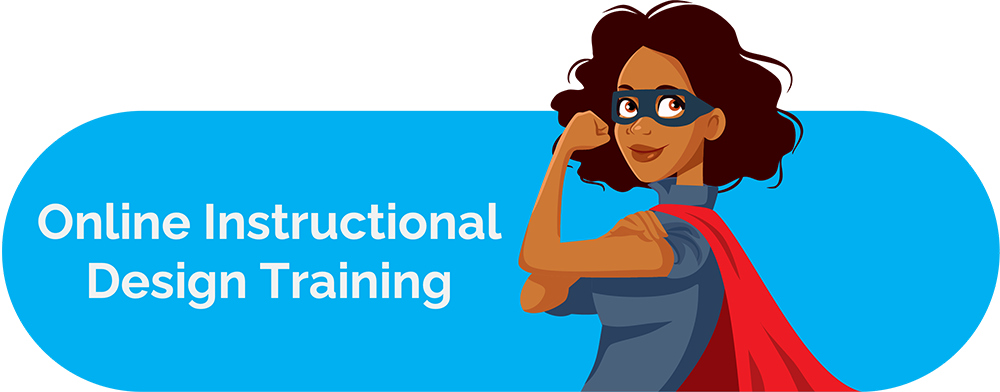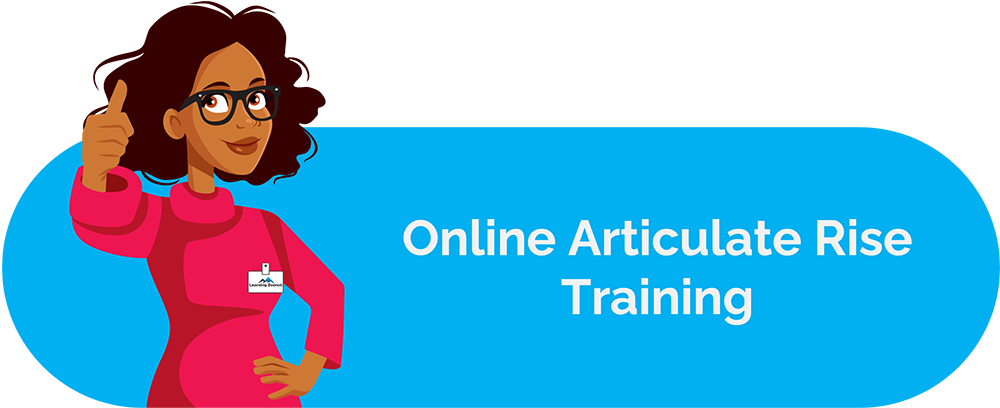e-Learning has rapidly become one of the mainstays of corporate training in the past 2 years, following the COVID-19 pandemic. This article will walk you through some e-learning secrets that will take your training modules up a notch.
Table of Contents
It has been shown to increase workforce retention by 26 – 60% (Research Institute of America) and generate 26% more revenue per employee (Docebo e-Learning Market Trends & Forecast, 2014-2016). Thus, businesses have opened up to e-learning’s benefits and are actively expanding their digital learning libraries.
What Makes e-learning Effective?
From a business standpoint, the most appealing perks of e-learning are:
- Cost-effectiveness: digital learning saves travel, venue, and material costs. Asynchronous learning also saves instructor costs. Its self-paced nature protects the business from any loss in productivity face-to-face training programs might cause.
- Time-efficiency: through e-learning courses, learners can gain 5 times more information in the same amount of time as face-to-face training. Additionally, it takes them 40-60% less time to complete training delivered via e-learning.
- Multimodal delivery suited to different kinds of learners: e-learning employs all the sensory modalities humans use to make courses engaging and multimodal. When information is absorbed in various complementary forms, memory retention improves.
- Course objectives guided by organizational goals: e-learning follows multiple instructional design models such as ADDIE, Merrill’s Principles, and the Agile method. All these approaches emphasize having clear objectives before designing instructional material. These objectives are derived from the organization’s business targets.
e-learning Secrets: The Essential Tricks of the Trade
Let us finally look at tips that can elevate any digital learning content.
1. Devise Compelling Learning Objectives and Plan Modules in Advance
A clear set of objectives should be the first step when developing e-learning content. Learning objectives are specific statements with an action verb, a singular result, and a clear behavioral outcome.
Outlining these establishes the training’s direction and the expected results. Learning objectives also help design assessments and evaluations.
Bloom’s Taxonomy is a handy framework for writing actionable and measurable outcomes for your e-learning course.
Developing preliminary storyboards and session plans becomes an easy task with a set of objectives. These outlines then guide the course format and content.
2. Make Courses Interactive
Adult learners are self-motivated and value the ability to direct the course of their learning. This is especially true in the digital era, where various content competes for the learner’s attention. Numerous factors influence people’s choices to consume or click away from what is on their screens.
E-learning is no different. It needs to have appeal and engagement for learners to complete it. The best way to do this is by making each course a fun and interactive experience.
David Merrill, a veteran in educational research, urges instructional designers to view courses as consumable products. By this logic, user experience principles should apply to all training modules.
The following elements can make your e-learning content more interactive:
- Gamification
- Avatars
- Badges and currencies
- Storytelling
- Pop-ups
- Interactive menus
- Drag and drop activities
- Microlearning
3. Engage the Learners Visually
Graphics are the backbone of content geared at the modern learner. 65% of individuals identify as visual learners today (visualteachingalliance.com).
Visual media is a powerful medium of transmitting information. It simplifies complex verbal concepts, reduces cognitive load, and reinforces learning. It’s the quickest form of processing information humans currently use.
Content creators have a wide range of options to choose from when selecting visual elements for their course, such as:
- GIFs
- Videos
- Infographics
- Vectors
- Pictures
- Timelines
- Maps
- Venn diagrams
4. Provide Meaningful Feedback
Due to its digital nature, e-learning can lag in terms of instructor and cross-student feedback.
Thus, it is up to the course creator to tackle this drawback. Feedback is an essential part of learning, and without it, learners can struggle to evaluate their progress.
All training modules should have formative and summative assessments. By using points, grades, stars, badges, etc., the evaluation of learners’ progress can be communicated to them. However, such brief feedback is not meaningful enough. Thus, encouraging messages, the reasoning behind right and wrong answers, and a doubt resolution feature must accompany the former elements.
Additionally, picking an LMS with forums, chatrooms, servers, and social media integration might be a good idea.
5. Follow a Responsive Design Approach
Responsive e-learning courses are optimized for different device types, orientations, and resolutions. The content of the course remains the same across all devices; however, the presentation changes.
For example, a responsive e-learning course might feature vertical scrolling and narrower blocks for mobile devices and horizontal scrolling with wider blocks on a desktop or laptop.
When making responsive courses, an important thing to keep in mind is to keep the stylistic elements, such as fonts, colors, graphics, etc., the same for all formats. This keeps the course cohesive and doesn’t make changing from one device to another an abrupt experience for the learner.
HTML5 is a technology popularly used to make responsive e-learning courses. There are some free, open-source versions of it for budget-strapped businesses or companies looking for a cheap option to experiment with.
6. Leverage the Benefits of Mobile Learning
A responsive e-learning course will definitely be optimized for mobile phones. Companies can take this a step further and adopt a mobile-first approach or design courses specifically for mobile phones.
Today, most people own a smartphone and use it to manage their daily lives. Mobile learning, or, m-learning, is nearing ubiquity due to its convenience. According to ReviewMoose.com, mobile learning courses have a staggering completion rate of 72%.
Mobile learning also enhances the self-paced nature of adult e-learning and can drive increased adoption of asynchronous e-learning modules.
7. Use Agile Methodology – the Power of Collaboration
Lastly, using an Agile methodology to develop courses can help distribute and manage time, clearly define roles, and improve collaboration between teams and stakeholders.
In an Agile course designing approach, course development is guided by predetermined objectives that design teams, stakeholders, executives, managers, and learners collaboratively define. Then, the course is developed in short bursts known as “sprints”. Feedback sessions follow sprints. And feedback leads to more sprints. After multiple such cycles, the course is ready to go.
The Agile methodology helps produce a robust quality control system.
Closing Remarks
Developing enriching and learner-centric training material optimized for various devices is a complex and elaborate task. Ensuring completion and meaningful learning requires careful design and development. The e-learning secrets mentioned in this article can help businesses improve their training content. However, professional e-learning services might be the answer if all else fails.
Infographics
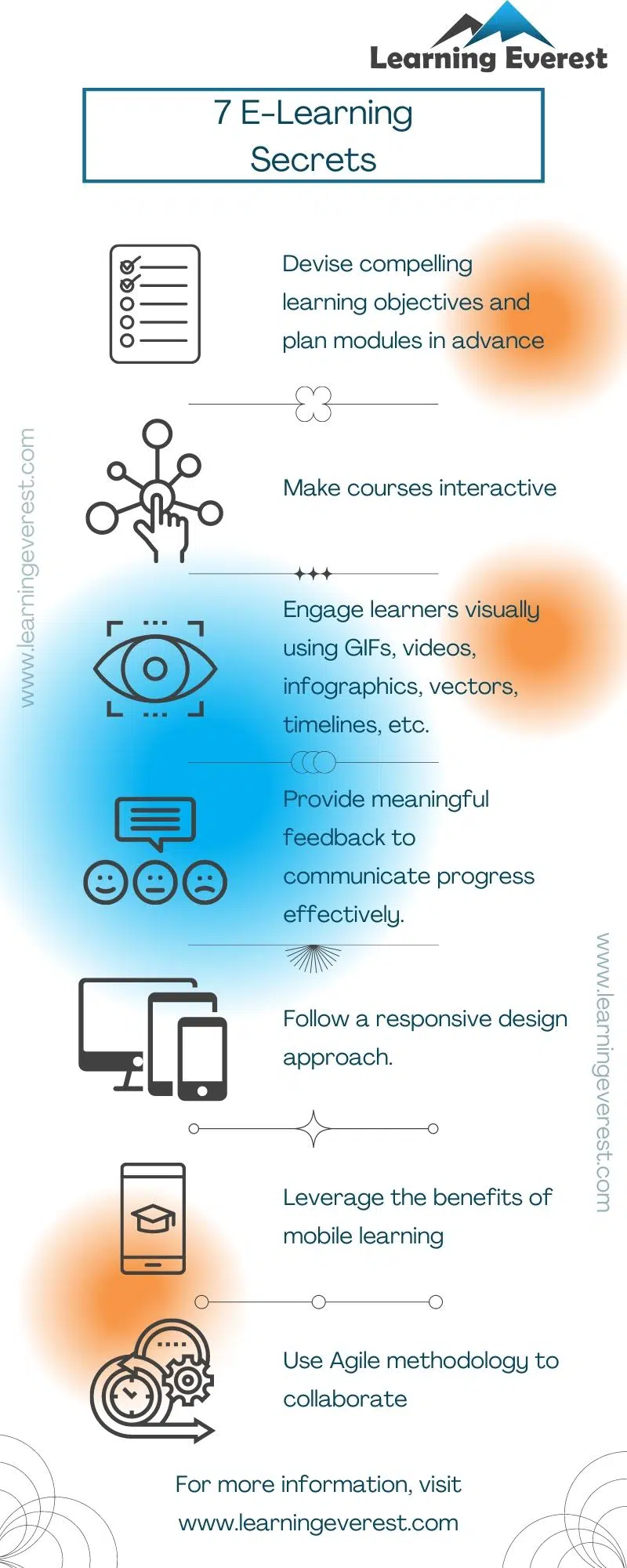
7 e-Learning Secrets
Frequently Asked Questions (FAQs)
How can I make my e-Learning better?
Make e-learning better by:
- Defining compelling objectives
- Making courses interactive
- Visually engaging learners
- Providing meaningful feedback
- Following a responsive design approach
- Leveraging the benefits of m-learning
- Using Agile methodology
What makes e-learning successful?
e-learning is effective because it is
- Cost-effective
- Time-efficient
- Multimodal and catered to different learners
- Guided by course objective and organizational goals
What is Agile e-Learning?
In an Agile course designing approach, course development is guided by predetermined objectives that design teams, stakeholders, executives, managers, and learners collaboratively define. Then, the course is developed in short bursts known as “sprints”. Feedback sessions follow sprints. And feedback leads to more sprints. After multiple such cycles, the course is ready to go.
The Agile methodology helps produce a robust quality control system.


